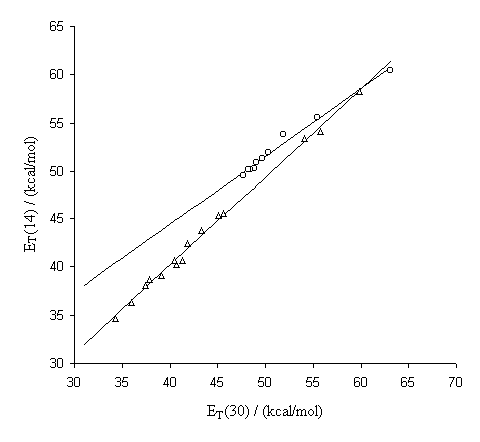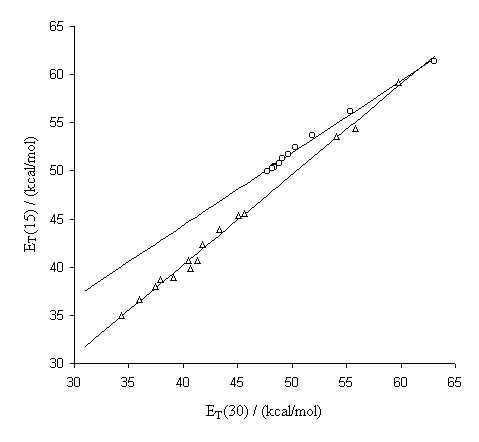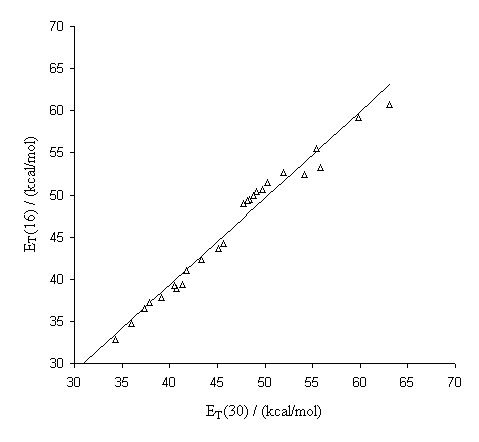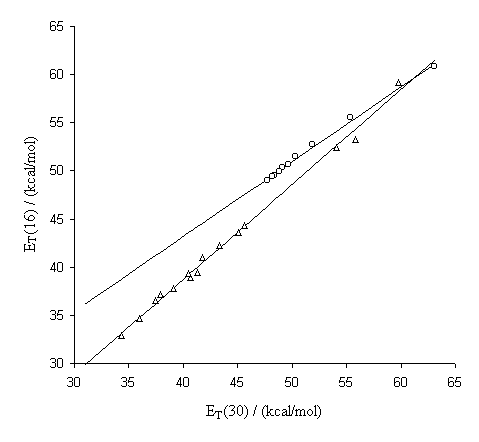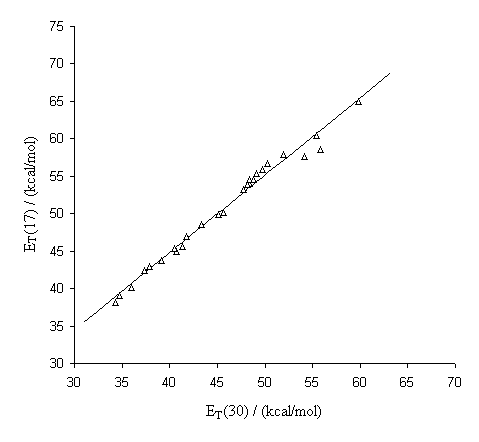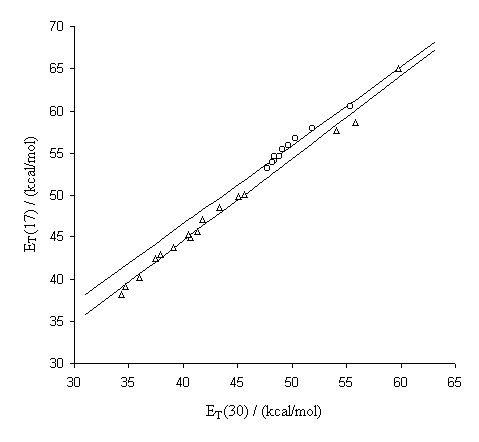|
|
|
Lösungsmittel |
ET(30) (kcal/mol) |
l max(14) (nm) |
ET(14) (kcal/mol) |
|
Wasser |
63.1 |
473 |
60.4 |
|
2,2,2-Trifluorethanol |
59.8 |
491 |
58.2 |
|
Formamid |
55.8 |
529 |
54.0 |
|
Methanol |
55.4 |
514 |
55.6 |
|
N-Methylformamid |
54.1 |
536 |
53.3 |
|
Ethanol |
51.9 |
538 |
53.1 |
|
1-Propanol |
50.3 |
550 |
52.0 |
|
1-Butanol |
49.7 |
557 |
51.3 |
|
1-Pentanol |
49.1 |
562 |
50.9 |
|
1-Hexanol |
48.8 |
568 |
50.3 |
|
1-Heptanol |
48.4 |
570 |
50.2 |
|
2-Propanol |
48.4 |
569 |
50.2 |
|
1-Octanol |
48.2 |
570 |
50.2 |
|
1-Decanol |
47.7 |
578 |
49.5 |
|
Acetonitril |
45.6 |
629 |
45.5 |
|
Dimethylsulfoxid |
45.1 |
632 |
45.2 |
|
N,N-Dimethylformamid |
43.3 |
653 |
43.8 |
|
Aceton |
41.8 |
675 |
42.4 |
|
1,2-Dichlorethan |
41.3 |
703 |
40.7 |
|
Dichlormethan |
40.7 |
709 |
40.3 |
|
Pyridin |
40.5 |
703 |
40.7 |
|
Chloroform |
39.1 |
731 |
39.1 |
|
Essigsäureethylester |
37.9 |
738 |
38.7 |
|
Tetrahydrofuran |
37.4 |
750 |
38.1 |
|
1,4-Dioxan |
36.0 |
787 |
36.3 |
|
t-Butyl-methyl-ether |
34.7 |
n. löslich |
- |
|
Benzen |
34.3 |
824 |
34.7 |
|
Tetrachlormethan |
32.4 |
n. löslich |
- |
|
Cyclohexan |
30.9 |
n. löslich |
- |
|
Tabelle 6: |
Längstwellige UV/Vis-Absorptionsmaxima und ET-Werte des Betains 14 sowie die ET(30)-Werte des Betains 1 |
|
|
|
|
|
|
|
|
|
|
|
Lösungsmittel |
ET(30) (kcal/mol) |
l max(15) (nm) |
ET(15) (kcal/mol) |
|
Wasser |
63.1 |
465 |
61.5 |
|
2,2,2-Trifluorethanol |
59.8 |
483 |
59.2 |
|
Formamid |
55.8 |
526 |
54.4 |
|
Methanol |
55.4 |
509 |
56.2 |
|
N-Methylformamid |
54.1 |
534 |
53.5 |
|
Ethanol |
51.9 |
533 |
53.6 |
|
1-Propanol |
50.3 |
546 |
52.4 |
|
1-Butanol |
49.7 |
553 |
51.7 |
|
1-Pentanol |
49.1 |
557 |
51.3 |
|
1-Hexanol |
48.8 |
563 |
50.8 |
|
1-Heptanol |
48.4 |
566 |
50.5 |
|
2-Propanol |
48.4 |
567 |
50.4 |
|
1-Octanol |
48.2 |
568 |
50.3 |
|
1-Decanol |
47.7 |
572 |
50.0 |
|
Acetonitril |
45.6 |
627 |
45.6 |
|
Dimethylsulfoxid |
45.1 |
630 |
45.4 |
|
N,N-Dimethylformamid |
43.3 |
651 |
43.9 |
|
Aceton |
41.8 |
674 |
42.4 |
|
1,2-Dichlorethan |
41.3 |
703 |
40.7 |
|
Dichlormethan |
40.7 |
716 |
39.9 |
|
Pyridin |
40.5 |
703 |
40.7 |
|
Chloroform |
39.1 |
735 |
38.9 |
|
Essigsäureethylester |
37.9 |
739 |
38.7 |
|
Tetrahydrofuran |
37.4 |
752 |
38.0 |
|
1,4-Dioxan |
36.0 |
782 |
36.6 |
|
t-Butyl-methyl-ether |
34.7 |
n. löslich |
- |
|
Benzen |
34.3 |
817 |
35.0 |
|
Tetrachlormethan |
32.4 |
n. löslich |
- |
|
Cyclohexan |
30.9 |
n. löslich |
- |
|
Tabelle 7: |
Längstwellige UV/Vis-Absorptionsmaxima und ET-Werte des Betains 15 sowie die ET(30)-Werte des Betains 1 |
|
|
|
|
|
|
|
|
|
|
|
Lösungsmittel |
ET(30) (kcal/mol) |
l max(16) (nm) |
ET(16) (kcal/mol) |
|
Wasser |
63.1 |
470 |
60.8 |
|
2,2,2-Trifluorethanol |
59.8 |
483 |
59.2 |
|
Formamid |
55.8 |
536 |
53.3 |
|
Methanol |
55.4 |
515 |
55.5 |
|
N-Methylformamid |
54.1 |
546 |
52.4 |
|
Ethanol |
51.9 |
542 |
52.8 |
|
1-Propanol |
50.3 |
555 |
51.5 |
|
1-Butanol |
49.7 |
563 |
50.8 |
|
1-Pentanol |
49.1 |
568 |
50.3 |
|
1-Hexanol |
48.8 |
573 |
49.9 |
|
1-Heptanol |
48.4 |
577 |
49.6 |
|
2-Propanol |
48.4 |
578 |
49.5 |
|
1-Octanol |
48.2 |
579 |
49.4 |
|
1-Decanol |
47.7 |
584 |
49.0 |
|
Acetonitril |
45.6 |
646 |
44.3 |
|
Dimethylsulfoxid |
45.1 |
656 |
43.6 |
|
N,N-Dimethylformamid |
43.3 |
677 |
42.2 |
|
Aceton |
41.8 |
698 |
41.0 |
|
1,2-Dichlorethan |
41.3 |
726 |
39.4 |
|
Dichlormethan |
40.7 |
735 |
38.9 |
|
Pyridin |
40.5 |
727 |
39.3 |
|
Chloroform |
39.1 |
756 |
37.8 |
|
Essigsäureethylester |
37.9 |
769 |
37.2 |
|
Tetrahydrofuran |
37.4 |
783 |
36.5 |
|
1,4-Dioxan |
36.0 |
825 |
34.7 |
|
t-Butyl-methyl-ether |
34.7 |
n. löslich |
- |
|
Benzen |
34.3 |
868 |
32.9 |
|
Tetrachlormethan |
32.4 |
n. löslich |
- |
|
Cyclohexan |
30.9 |
n. löslich |
- |
|
Tabelle 8: |
Längstwellige UV/Vis-Absorptionsmaxima und ET-Werte des Betains 16 sowie die ET(30)-Werte des Betains 1 |
|
|
|
|
|
|
|
|
|
|
|
Lösungsmittel |
ET(30) (kcal/mol) |
l max(17) (nm) |
ET(17) (kcal/mol) |
|
Wasser |
63.1 |
n. meßbar |
- |
|
2,2,2-Trifluorethanol |
59.8 |
440 |
65.0 |
|
Formamid |
55.8 |
488 |
58.6 |
|
Methanol |
55.4 |
473 |
60.4 |
|
N-Methylformamid |
54.1 |
496 |
57.6 |
|
Ethanol |
51.9 |
494 |
57.9 |
|
1-Propanol |
50.3 |
504 |
56.7 |
|
1-Butanol |
49.7 |
511 |
56.0 |
|
1-Pentanol |
49.1 |
516 |
55.4 |
|
1-Hexanol |
48.8 |
523 |
54.7 |
|
1-Heptanol |
48.4 |
528 |
54.1 |
|
2-Propanol |
48.4 |
523 |
54.7 |
|
1-Octanol |
48.2 |
531 |
53.8 |
|
1-Decanol |
47.7 |
538 |
53.1 |
|
Acetonitril |
45.6 |
571 |
50.1 |
|
Dimethylsulfoxid |
45.1 |
573 |
49.9 |
|
N,N-Dimethylformamid |
43.3 |
589 |
48.5 |
|
Aceton |
41.8 |
608 |
47.0 |
|
1,2-Dichlorethan |
41.3 |
627 |
45.6 |
|
Dichlormethan |
40.7 |
637 |
44.9 |
|
Pyridin |
40.5 |
631 |
45.3 |
|
Chloroform |
39.1 |
655 |
43.7 |
|
Essigsäureethylester |
37.9 |
666 |
42.9 |
|
Tetrahydrofuran |
37.4 |
675 |
42.4 |
|
1,4-Dioxan |
36.0 |
710 |
40.3 |
|
t-Butyl-methyl-ether |
34.7 |
731 |
39.1 |
|
Benzen |
34.3 |
748 |
38.2 |
|
Tetrachlormethan |
32.4 |
n. löslich |
- |
|
Cyclohexan |
30.9 |
n. löslich |
- |
|
Tabelle 9: |
Längstwellige UV/Vis-Absorptionsmaxima und ET-Werte des Betains 17 sowie die ET(30)-Werte des Betains 1 |
|
|
|
|
|
|
|
|

